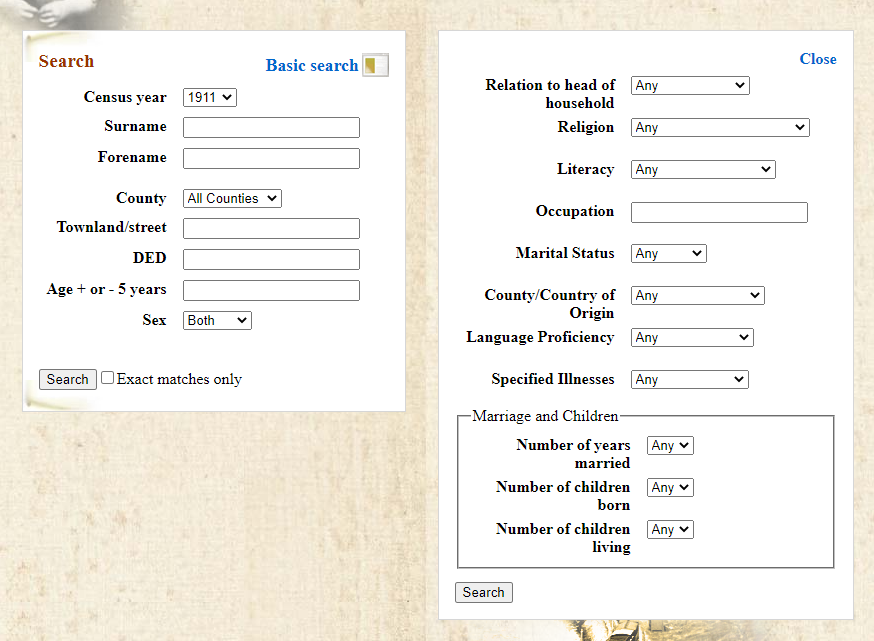It's often the first place we start, these records are free and relatively easy to search. Even with the loss of earlier Census records, the 1901 and 1911 returns give a clear snapshot of Irish inhabitants, household by household.
The Census can be searched by name, location, and age, as well as by using more advanced search options. Once you have located your ancestors, you can even see their handwriting, as the original Census returns are available to view!

What information does the census contain?
Ireland is unusual among English-speaking census-taking countries in that our original household manuscript returns survive. These are the forms filled out and signed by the head of each household on census night. Most other countries only have Enumerators' books, where family details were transcribed by the person charged with collecting the census information.
The basic topographical divisions for the census are:
- County;
- District Electoral Division;
- Townland or Street.
This is a simple hierarchical structure that makes it easy to access any area in the country. The returns are arranged in clusters by townland/street within the district electoral division within the county. For each townland/street, there are a number of original household returns, filled in and signed by heads of households, and three statistical returns, dealing with religious denominations, classification of buildings, and out-offices and farm-steadings, filled out by the Enumerator for that townland/street.
The various forms you will encounter are as follows:
-
B1 Form - House and Building Form - Details of the houses and buildings in a particular street/townland - information such as the type of building, class of building, how many families lived in each house, how many rooms and the name of the head of the household, see example below
-
B2 Form - Details of any extra buildings for example stables etc
-
N Form - Enumerators summary which includes religious denomination
-
Institutional & Shipping Forms - details of the occupants of institutions of different kinds, for example, barracks, workhouses, hospitals, colleges, orphanages etc. In many cases the names of occupants are only given in initial form, ie Mary Smith is entered as M.S.
More information about what a townland is can be found HERE
1901 and 1911 Census of Ireland
The Census records for these two early 20th century Censuses give information about every household in Ireland. This information includes family members, occupations, ages, counties of birth, literacy and marital status. In addition, the forms associated with each household return give further information as to the type of building as well as the occupancy and the occupation of the family.
The Censuses can also be searched by a variety of options including religion, occupation, relationship to head of family, literacy status, county or country of origin, Irish language proficiency, specified illnesses, and child survival information. These options can be very helpful if there is difficulty with finding a family member or household. In order to avail of this option, use the Search form below, and click on the “More Search Options” button at the bottom of the form and from a dropdown menu, one of the above options can be chosen.
Sharon Slater from Limericks Life has kindly allowed us to share her tips for getting the most of the 1901/1911 census.
Irish Census Basic Search Options
Irish Census More Search Options
Search the 1901/1911 Census, Form A and B
The 1911 Census also asked other questions and in particular, the number of children born in each family and those living was a question asked as well as the number of years that a couple was married. These two new features of that particular Census can also be used to narrow down further family history.
1841 and 1851 Census Returns
The loss of the earlier Census records is a hurdle for anyone interested in tracing their Family history, but all is not lost. There are a number of earlier Censuses available on the National Archives website and these should not be overlooked as they may contain information. There are extracts for 1821-1851 which are available for a number of counties – particularly for the 1841 and 1851 Census Returns.
Picture above: Excerpt from the 1821 Census of Ireland Returns for Abbey Lane, in Athenry Town.
In addition, the Census Search Forms for the 1841 & 1851 Census Returns are available as a separate link on the National Archives site. These forms were used for those applications who wanted to avail of the Old Age Pensions Act of 1908. In order to have a successful application, they needed to prove that they were 70 years of age upon the date of application. The 1841 & 1851 Census returns were needed for that purpose.
Picture above: Excerpt from the 1841 Census of Ireland Returns for Omagh in County Tyrone.
Search 1841 and 1851 Census Returns
The next awaited Census is that of 1926 which will become available in the next 5 years. This Census will be of invaluable assistance as it is the first Census that the Irish Free State undertook as its own country. Information on this will be updated as it becomes available.
Watch our webinar on Irish Census and Substitutes
Do your ancestors appear on either the 1901 or 1911 Census? Add them to their Irish place of origin and share their story with people living there today and descendants of the area now living all over the world.
Read More
We hope you have found the information we have shared helpful. While you are here, we have a small favour to ask. Ireland Reaching Out is a non-profit organisation that relies on public funding and donations to ensure a completely free family history advisory service to anyone of Irish heritage who needs help connecting with their Irish place of origin. If you would like to support our mission, please click on the donate button and make a contribution. Any amount, big or small, is appreciated and makes a difference.




